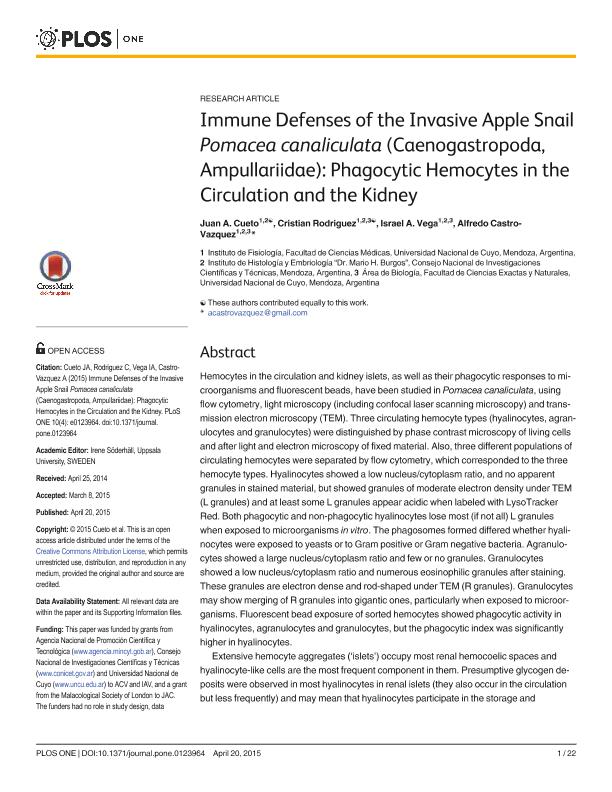Artículo
Immune Defenses of the Invasive Apple Snail Pomacea canaliculata (Caenogastropoda, Ampullariidae): Phagocytic Hemocytes in the Circulation and the Kidney
Fecha de publicación:
04/2015
Editorial:
Public Library of Science
Revista:
Plos One
ISSN:
1932-6203
Idioma:
Inglés
Tipo de recurso:
Artículo publicado
Clasificación temática:
Resumen
Hemocytes in the circulation and kidney islets, as well as their phagocytic responses to microorganisms and fluorescent beads, have been studied in Pomacea canaliculata, using flow cytometry, light microscopy (including confocal laser scanning microscopy) and transmission electron microscopy (TEM). Three circulating hemocyte types (hyalinocytes, agranulocytes and granulocytes) were distinguished by phase contrast microscopy of living cells and after light and electron microscopy of fixed material. Also, three different populations of circulating hemocytes were separated by flow cytometry, which corresponded to the three hemocyte types. Hyalinocytes showed a low nucleus/cytoplasm ratio, and no apparent granules in stained material, but showed granules of moderate electron density under TEM (L granules) and at least some L granules appear acidic when labeled with LysoTracker Red. Both phagocytic and non-phagocytic hyalinocytes lose most (if not all) L granules when exposed to microorganisms in vitro. The phagosomes formed differed whether hyalinocytes were exposed to yeasts or to Gram positive or Gram negative bacteria. Agranulocytes showed a large nucleus/cytoplasm ratio and few or no granules. Granulocytes showed a low nucleus/cytoplasm ratio and numerous eosinophilic granules after staining.These granules are electron dense and rod-shaped under TEM (R granules). Granulocytes may show merging of R granules into gigantic ones, particularly when exposed to microorganisms.Fluorescent bead exposure of sorted hemocytes showed phagocytic activity in hyalinocytes, agranulocytes and granulocytes, but the phagocytic index was significantly higher in hyalinocytes.Extensive hemocyte aggregates (?islets?) occupy most renal hemocoelic spaces and hyalinocyte-like cells are the most frequent component in them. Presumptive glycogen deposits were observed in most hyalinocytes in renal islets (they also occur in the circulation but less frequently) and may mean that hyalinocytes participate in the storage and circulation of this compound. Injection of microorganisms in the foot results in phagocytosis by hemocytes in the islets, and the different phagosomes formed are similar to those in circulating hyalinocytes. Dispersed hemocytes were obtained after kidney collagenase digestion and cell sorting, and they were able to phagocytize fluorescent beads. A role for the kidney as an immune barrier is proposed for this snail.
Archivos asociados
Licencia
Identificadores
Colecciones
Articulos(IHEM)
Articulos de INST. HISTOLOGIA Y EMBRIOLOGIA DE MEND DR.M.BURGOS
Articulos de INST. HISTOLOGIA Y EMBRIOLOGIA DE MEND DR.M.BURGOS
Citación
Cueto, Juan Agustin; Rodriguez, Cristian; Vega, Israel Aníbal; Castro Vazquez, Alfredo Juan; Immune Defenses of the Invasive Apple Snail Pomacea canaliculata (Caenogastropoda, Ampullariidae): Phagocytic Hemocytes in the Circulation and the Kidney; Public Library of Science; Plos One; 10; 4; 4-2015; 1-22
Compartir
Altmétricas




